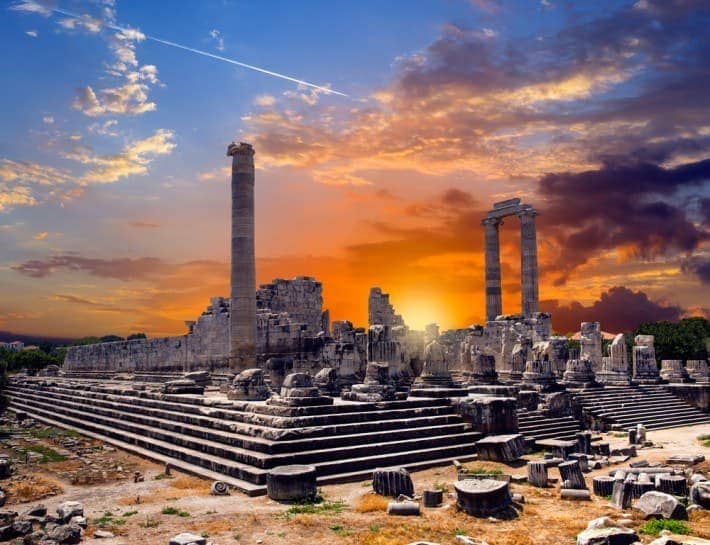
Didyma Temple of Apollo
Massive Ionic temple ruins, once a vital oracle site, offering a unique, accessible journey into ancient Greek history.

Highlights
Must-see attractions

Social
From TikTok & Reddit
Best Time
Fewer crowds, cooler temps

Didyma Temple of Apollo
Best Time
Fewer crowds, cooler temps

Highlights
Must-see attractions
Massive Ionic temple ruins, once a vital oracle site, offering a unique, accessible journey into ancient Greek history.
"You're free to walk right up the temple steps and wander around at your own pace, which I loved."

🌅 Sunset Magic
Visit in the evening for cooler temperatures and a spectacular sunset over the ruins. :city_sunset:
🚶♀️ Wander Freely
Explore the site at your own pace; you can walk among the ruins and touch the ancient stones. :hiking_boot:

Highlights
Discover the most iconic attractions and experiences

Majestic Columns
Temple grounds
Towering Ionic columns, some of the largest in the ancient world, still stand, evoking a sense of awe and grandeur.

The Oracle's Inner Sanctum
Temple interior
Experience the powerful presence of the inner sanctuary where the famed oracle once spoke, with striking acoustics.

Sunset Spectacle
Temple grounds
Witness breathtaking sunsets over the ancient ruins, creating a magical and unforgettable atmosphere.
Plans like a pro.
Thinks like you
Planning Your Visit
Timing is Everything
Explore Freely
Best Times
Insider Tips
from TikTok, Instagram & Reddit
🌅 Sunset Magic
Visit in the evening for cooler temperatures and a spectacular sunset over the ruins. :city_sunset:
🚶♀️ Wander Freely
Explore the site at your own pace; you can walk among the ruins and touch the ancient stones. :hiking_boot:
💰 Budget-Friendly Entry
Admission is affordable (around 6 euros). Skip tours and save money by using informational boards. :euro:
🚌 Easy Bus Access
Take the No. 4 bus to get close to the temple; it's a short walk from the bus stop. :bus:
Tips
from all over the internet
🌅 Sunset Magic
Visit in the evening for cooler temperatures and a spectacular sunset over the ruins. :city_sunset:
🚶♀️ Wander Freely
Explore the site at your own pace; you can walk among the ruins and touch the ancient stones. :hiking_boot:
💰 Budget-Friendly Entry
Admission is affordable (around 6 euros). Skip tours and save money by using informational boards. :euro:
🚌 Easy Bus Access
Take the No. 4 bus to get close to the temple; it's a short walk from the bus stop. :bus:
🏛️ Impressive Scale
Prepare to be amazed by the sheer size and unfinished grandeur of this ancient Ionic temple.
What Travellers Say
Reviews Summary
Visitors praise the Temple of Apollo for its awe-inspiring scale, well-preserved ruins, and the unique freedom to explore and touch the ancient stones. The affordability and accessibility, especially via public transport, are also highlighted. Some note ongoing construction near the entrance, but the overall grandeur remains impactful.
"I visited the Temple of Apollo in early September on a weekday, and it was a great, with hardly any other tourists. The quiet made it easy to take in the atmosphere. We skipped the headphone guide since there are plenty of well-written boards around the site.
You’re free to walk right up the temple steps and wander around at your own pace, which I loved. The inner sanctum, where the oracle once spoke, still carries a strong presence. The acoustics there are striking; even a soft voice carries.
If you’re after an authentic ancient site that hasn’t been overrun by crowds, this is a place I’d highly recommend. It feels both accessible and special."
Marg Erydoor
"It is a very very great historical place and it is in quite good situation and well preserved…
Definitely recommend to visit it…
We visited the Temple of Apollo and it was really really great due to the fact first of all that the facade lightings were very lovely and second it was marvellous to run away from day heat so by the evening visit you really can enjoy the the site in a more different way because the evening hours provides more cooler temperature and on the other hand it has also less crowded environment…"
Bilge Sonmezer
"The Temple of Apollo in Didim is an absolute gem! From the moment you arrive, you're greeted by the awe-inspiring ruins. It wasn’t just a temple; it was home to one of the most famous oracles of the ancient Greek world, second only to Delphi. Pilgrims from across the Mediterranean traveled there to consult the oracle, making it a major spiritual and cultural hub.
You should definitely visit this historical place."
Nuri Mehmed
What People Like
What People Dislike
Frequently Asked Questions
🚇 🗺️ Getting There
The Temple of Apollo is located near Didim, Turkey. You can reach it by car or by taking the local No. 4 bus route, which stops a short walk away. Many visitors combine a trip here with other coastal attractions in the Aydın region.
While specific parking details can vary, it's generally advisable to check for designated parking areas upon arrival. The site is accessible by road, and local transport options are also available.
The temple is about 3.8 kilometers north of Altinkum, a popular area in Didim. While walkable, it might be a considerable distance depending on the heat. Taking a local bus or taxi is often more convenient.
From major cities like Istanbul or Izmir, you can take a bus to Didim. The journey can take several hours. Alternatively, flying into Bodrum or Izmir airports and then arranging ground transportation is an option.
While organized tours are available, many visitors opt for independent travel using public transport or rental cars. Informational boards at the site provide context, and audio guides may also be an option.
🎫 🎫 Tickets & Entry
Admission to the Temple of Apollo is quite affordable, typically around 6 euros per person. This makes it a great value for experiencing such a significant historical site.
Opening hours can vary seasonally, but the temple is generally accessible during daylight hours. It's recommended to check the latest hours before your visit, especially if planning an early morning or late evening trip.
Advance booking is usually not required for the Temple of Apollo. Tickets can typically be purchased on-site. However, during peak tourist seasons, it's always a good idea to check for any specific booking recommendations.
While you can freely wander the ruins, be mindful of any fenced-off areas or ongoing preservation work. Security cameras are in place, so climbing fences is not permitted. The site is generally very accessible.
Yes, there are well-written informational boards around the site that provide details about the temple's history and significance. Some visitors opt to skip headphone guides, finding the on-site information sufficient.
🎫 🏛️ Onsite Experience
Marvel at the colossal Ionic columns, explore the inner sanctuary with its unique acoustics, and imagine the ancient oracle. You can freely walk among the ruins and touch the stones, offering a unique connection to history.
While it has suffered damage from earthquakes, the Temple of Apollo is remarkably well-preserved, especially considering its age. The massive scale and many architectural refinements are still evident.
Absolutely! The Temple of Apollo offers incredible photographic opportunities, especially with its grand scale and the surrounding landscape. The sunset views are particularly popular for photography.
Didyma was a major sanctuary and one of the most famous oracle centers in the ancient Greek world, second only to Delphi. Pilgrims traveled from across the Mediterranean to consult the oracle of Apollo.
The site has paved paths, allowing for exploration. However, as it is a ruin, some areas might have uneven terrain. It's advisable to check accessibility details closer to your visit.
📸 📸 Photography
The golden hour, just before sunset, offers the most magical light for photography, casting a warm glow on the ancient stones. Early mornings can also provide soft light and fewer people.
Popular shots include wide-angle views of the massive columns, close-ups of architectural details, and capturing the scale by including people in the frame. Sunset shots are also highly sought after.
Drone usage regulations can vary by location and are often restricted at historical sites to protect the ruins and ensure visitor safety. It's best to check local regulations before flying a drone.
A wide-angle lens is great for capturing the immense scale of the temple. A standard zoom lens is versatile for various shots. Consider a tripod for low-light photography during sunset.
Absolutely! The ruins provide a dramatic backdrop for creative photography. Experiment with different angles, light, and compositions to capture the unique atmosphere of the site.
For Different Travelers
Tailored advice for your travel style
👨👩👧 Families with Kids
Consider visiting in the late afternoon to avoid the peak heat and crowds, making the experience more comfortable for younger visitors. The site is generally accessible via paved paths, though some areas might have uneven ground. Bringing water and snacks is always a good idea for family outings.
💰 Budget Travelers
Getting there is also cost-effective. The No. 4 bus route provides convenient access to the temple from Didim, and the fare is minimal. This makes it easy to combine with other local attractions without breaking the bank.
📸 Photographers & History Buffs
History enthusiasts will be captivated by Didyma's past as a major oracle site and its impressive Ionic architecture. The ability to walk freely among the ruins and touch the ancient stones provides a rare and intimate connection to history. The site's grandeur, even in its unfinished state, is a testament to ancient engineering and ambition.
Deep Dives
In-depth insights and expert knowledge
The Oracle of Didyma: A Spiritual Hub
The process of consulting the oracle was elaborate, involving rituals and interpretations by priestesses. The inner sanctum, where the oracle was believed to reside, still holds a palpable sense of mystery and power, with its remarkable acoustics amplifying even the softest sounds. This spiritual significance made Didyma a crucial center for religious and political decision-making for centuries.
Even in its ruined state, the Temple of Apollo at Didyma continues to evoke a sense of wonder and reverence. Its history as a place of divine communication and its monumental architecture make it a compelling destination for anyone interested in ancient history and mythology.
Architectural Marvel: The Ionic Temple
Although the temple was never fully completed, its scale and the preserved refinements in its construction are astonishing. Even Roman emperors like Hadrian contributed to its development. The sheer magnitude of the structure, with its massive marble blocks, speaks to the incredible engineering and craftsmanship of the ancient Greeks.
Visitors today can walk among these monumental ruins and appreciate the architectural genius firsthand. The unfinished nature of the temple adds a unique layer to its story, hinting at the ambitious vision behind its creation. The temple's design and scale continue to inspire awe, making it a testament to ancient architectural prowess.
Experiencing Didyma: Beyond the Ruins
Many visitors recommend visiting during the late afternoon or early evening. This timing not only helps you avoid the midday heat but also offers the chance to witness a spectacular sunset over the ruins, creating a truly magical atmosphere. The cooler temperatures and fewer crowds in the evening enhance the contemplative experience of exploring such a significant historical site.
While the site is impressive, some visitors note that new entrance pavilions are being constructed, and access might be partially restricted by fences. However, even from behind the perimeter, the temple's immense scale provides an unforgettable impression. The paved paths around the temple allow for viewing from various angles, ensuring you can still appreciate its grandeur.



Social
from TikTok, Instagram & Reddit